
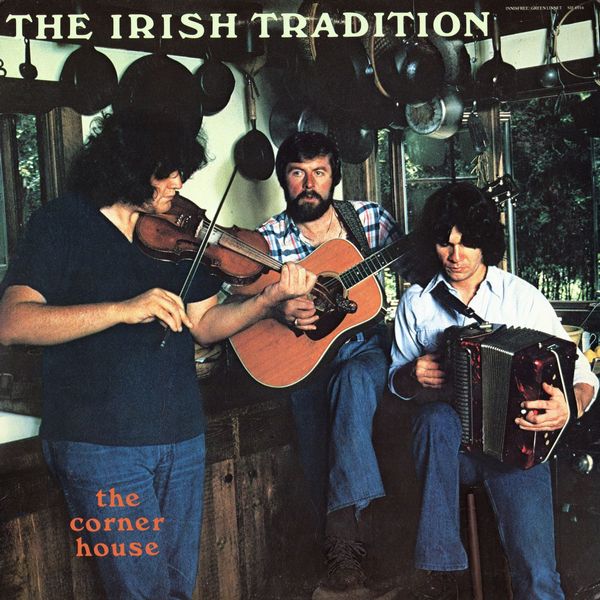 |
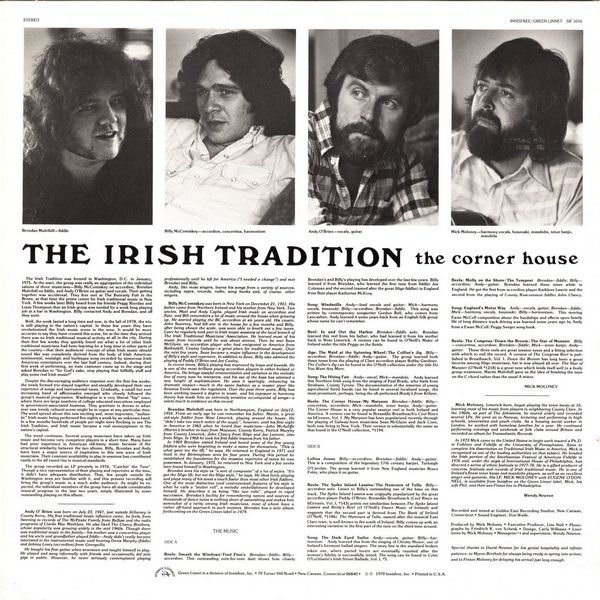
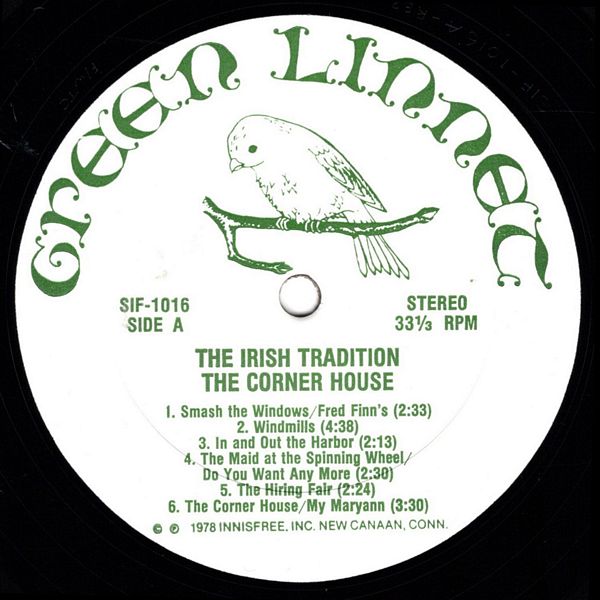

|
Sleeve Notes
The Irish Tradition was formed in Washington, D.C. in January, 1975. At the start, the group was really an aggregation of the individual talents of three musicians — Billy McComiskey on accordion, Brendan Mulvihill on fiddle, and Andy O'Brien on guitar and vocals. Their getting together was accidental. They first met at The Bunratty Pub in the Bronx, at that time the prime center for Irish traditional music in New York. A few weeks later Billy heard from his friends Peggy Riordan and Louis Thompson that an Irish group was needed for a week long playing job at a bar in Washington. Billy contacted Andy and Brendan, and off they went.
Well, the week lasted a long time and now, in the fall of 1978, the trio is still playing in the nation's capital. In these few years they have revolutionized the Irish music scene in the area. It would be more accurate to say they have created this scene, for at the time they arrived there was no Irish traditional musical activity at all in the city. During their first few weeks they quickly found out what a lot of other Irish traditional musicians had been learning for a long time in other parts of the country — that their audiences' concept of what Irish music should sound like was completely derived from the body of Irish American sentimental, nostalgic and burlesque song recorded by numerous Irish American entertainers over the last half century. Indeed, during their first week of performing, an irate customer came up to the stage and asked Brendan to "for God's sake, stop playing that hillbilly stuff and play some real Irish music!"
Despite the discouraging audience response over the first few weeks, the newly formed trio stayed together and steadily developed their own repertoire of songs and instrumental tunes. Gradually, a small but ever increasing band of aficionados emerged who closely followed the group's musical progression. Washington is a very liberal "hip" town, where there are large numbers of college educated executives employed in government-associated business. They gravitate in droves to whatever new trendy cultural scene might be in vogue at any particular time. The word spread about this new exciting and, most important, "authentic" Irish music being performed five nights a week by an unknown band. In a few months hundreds of people per night were flocking to see The Irish Tradition, and Irish music became a real moneyspinner in the nation's capital.
The trend continues. Several young musicians have taken up Irish music and become very competent players in a short time. Many have had prior experience in American old-timey music because of the structural similarity between the two idioms. Billy, Brendan and Andy have been a major source of inspiration to this new wave of Irish musicians. Their constant availability to play in sessions has contributed vastly to the all round rise in musical standards.
The group recorded an LP privately in 1976, "Catchin' the Tune". Though a nice representation of their playing and repertoire at the time, it didn't have adequate distribution. Thus, few people outside the Washington area are familiar with it, and this present recording will bring the group's music to a much wider audience. As might be expected, the individual members of the group have all made considerable musical progress in the last two years, amply illustrated by some outstanding playing on this album.
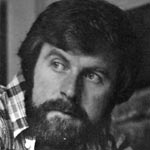 Andy O' Brien was born on July 23, 1947, just outside Killarney in County Kerry. His first traditional music influence came, he feels, from listening to records of The McPeake Family from Belfast and the radio programs of Ciaran Mac Mathuna. He also liked The Clancy Brothers, whose popularity was growing widely in the mid 1960s. Though there was traditional music in the family — his mother was a concertina player and his uncle and grandfather played fiddle — Andy didn't really become interested in the instrumental music until hearing Denis Murphy (fiddle) and Johnny Leary (accordion) from Gneeguilla.
Andy O' Brien was born on July 23, 1947, just outside Killarney in County Kerry. His first traditional music influence came, he feels, from listening to records of The McPeake Family from Belfast and the radio programs of Ciaran Mac Mathuna. He also liked The Clancy Brothers, whose popularity was growing widely in the mid 1960s. Though there was traditional music in the family — his mother was a concertina player and his uncle and grandfather played fiddle — Andy didn't really become interested in the instrumental music until hearing Denis Murphy (fiddle) and Johnny Leary (accordion) from Gneeguilla.
He bought his first guitar when seventeen and taught himself to play. He played and sang informally with friends and occasionally did solo gigs in public. However, he never seriously contemplated playing professionally until he left for America ("I needed a change") and met Brendan and Billy.
Andy, like most singers, learns his songs from a variety of sources, including tapes, records, radio, song books and, of course, other singers.
 Billy McComiskey was born in New York on December 21, 1951. His father came from Northern Ireland and his mother from New York. Two uncles, Matt and Andy Caplis, played Irish music on accordion and
flute, and Bill remembers a lot of music around the house when growing up. He started playing the BC accordion at six years old. His cousin. John Sweeney, had left one in the house for a few months and Billy, after being shown the scale, was soon able to knock out a few tunes. Later he regularly took part in Irish music sessions at the local branch of The Irish Traditional Musicians' Association. He learned most of his music from records until he was about sixteen. Then he met Seán McGlynn, an accordion player who had emigrated to America from Ballinakill, County Galway — a great place for traditional music. Over the next few years, Seán became a major influence in the development of Billy's style and repertoire. In addition to Seán, Billy also admired the playing of Paddy O'Brien and Joe Cooley.
Billy McComiskey was born in New York on December 21, 1951. His father came from Northern Ireland and his mother from New York. Two uncles, Matt and Andy Caplis, played Irish music on accordion and
flute, and Bill remembers a lot of music around the house when growing up. He started playing the BC accordion at six years old. His cousin. John Sweeney, had left one in the house for a few months and Billy, after being shown the scale, was soon able to knock out a few tunes. Later he regularly took part in Irish music sessions at the local branch of The Irish Traditional Musicians' Association. He learned most of his music from records until he was about sixteen. Then he met Seán McGlynn, an accordion player who had emigrated to America from Ballinakill, County Galway — a great place for traditional music. Over the next few years, Seán became a major influence in the development of Billy's style and repertoire. In addition to Seán, Billy also admired the playing of Paddy O'Brien and Joe Cooley.
In recent times, Billy's playing has improved by leaps and bounds. He is one of the most brilliant young accordion players in either Ireland or America. He brings tasteful ornamentation and variation to the melodic line of every tune he interprets, and his use of the bass has attained a new height of sophistication. He uses it sparingly, enhancing its dramatic impact — much in (he same fashion as a master piper like Seamus Ennis uses the regulators. Over the past three years, Billy has been working toward a degree in music, and his exposure to harmony theory has made him an extremely sensitive accompanist of songs — a talent much in evidence on this record.
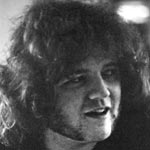 Brendan Mulvihill was born in Northampton, England on Julyl2, 1954. From an early age he can remember his father, Martin, a great old-style fiddler from West Limerick, playing around the house. He "didn't take too much notice of the music", however, until his first night in America in 1965 when he heard four musicians — John McAuliffe (Martin's brother-in-law) from Moyvane, County Kerry, Patrick Murphy from County Limerick, John Clancy from Sligo and Joe Lamont, also from Sligo. In 1968 he took his first fiddle lessons from his father.
Brendan Mulvihill was born in Northampton, England on Julyl2, 1954. From an early age he can remember his father, Martin, a great old-style fiddler from West Limerick, playing around the house. He "didn't take too much notice of the music", however, until his first night in America in 1965 when he heard four musicians — John McAuliffe (Martin's brother-in-law) from Moyvane, County Kerry, Patrick Murphy from County Limerick, John Clancy from Sligo and Joe Lamont, also from Sligo. In 1968 he took his first fiddle lessons from his father.
In 1969 Brendan visited Ireland and heard some of the fine young fiddlers who were beginning to make a name for themselves. "This what gave me the lift," he says. He returned to England in 1971 and lived in the Birmingham area for four years. During this period he established the foundation for the massive repertoire of tunes he now possesses. In January, 1975, he returned to New York and a few weeks later found himself in Washington.
Brendan sees his style as "a sort of composite" of a lot of styles. "It's got the Sligo lift, but not the Sligo style," he says. He likes lively playing and plays many of his tunes a touch faster than most other Irish fiddlers. One of the most distinctive (and controversial) features of his style is what he calls a "stutter roll", a melodic embellishment he developed himself. He describes it as being "like two rolls", played in rapid succession. Brendan's facility for remembering names and sources of thousands of dance tunes is nothing short of astonishing and makes him somewhat of a rarity among Irish musicians, most of whom have a rather off-hand approach to such matters. Brendan has a solo album forthcoming on the Green Linnet label in 1979.
 Mick Moloney, Limerick-born, began playing the tenor banjo at 16, learning most of his music from players in neighboring County Clare. In the 1960s, as part of
The Johnstons, he toured widely and recorded several LPs. He went on to Norway, lecturing and performing in high schools, universities and youth clubs. As a housing social worker in London, he worked with homeless families for a year. He continued performing evenings and weekends at folk clubs around Britain and recorded an album for Transatlantic Records.
Mick Moloney, Limerick-born, began playing the tenor banjo at 16, learning most of his music from players in neighboring County Clare. In the 1960s, as part of
The Johnstons, he toured widely and recorded several LPs. He went on to Norway, lecturing and performing in high schools, universities and youth clubs. As a housing social worker in London, he worked with homeless families for a year. He continued performing evenings and weekends at folk clubs around Britain and recorded an album for Transatlantic Records.
In 1973 Mick came to the United States to begin work toward a Ph.D. in Folklore and Folklife at the University of Pennsylvania. Soon to complete his dissertation on Traditional Irish Music in America, Mick is recognized as one of the leading authorities on that subject. He headed the Irish portion of the Smithsonian Festival of American Folklife in 1976 and, under the aegis of International House of Philadelphia, has directed a series of ethnic festivals in 1977-78. He is a gifted producer of concerts, festivals and records of Irish traditional music. He is one of Ireland's finest tenor banjo and mandolin players, as well as an excellent singer and guitarist. His LP, MICK MOLONEY with EUGENE O'DONNELL, is available from Innisfree on the Green Linnet label. Mick, his wife Phil, and their son Fintan live in Philadelphia.
Reels: Smash the Windows/Fred Finn's
Brendan — fiddle; Billy-accordion.
This outstanding note-for-note duet shows how closely Brendan's and Billy's playing has developed over the last few years. Billy learned it from Brendan, who learned the first tune from fiddler Joe Coleman and the second (named after the great Sligo fiddler) in England from flute player Katherine McEvoy.
Song: Windmills
Andy — lead vocals and guitar; Mick — harmony vocals, bouzouki; Billy — accordion; Brendan — fiddle.
This song was written by contemporary song-writer Gordon Bell, who comes from Lancashire. Andy learned it some years back from an English folk group whose name he can't remember.
Reel: In and Out the Harbor
Brendan — fiddle solo.
Brendan learned this reel from his father, who had learned it from his mother back in West Limerick. A version can be found in O'Neill's Music of Ireland under the title Peggy on the Settle.
Jigs: The Maid at the Spinning Wheel/The Collier's Jig
Billy-accordion; Brendan — fiddle; Andy — guitar.
The group learned both these tunes from the playing of Clare accordion player Bobby Gardiner. The Collier's Jig can be found in the O'Neill collection under the title Do You Want Any More.
Song: The Hiring Fair
Andy — vocal; Mick — mandola.
Andy learned this Northern Irish song from the singing of Paul Brady, who hails from Strabane, County Tyrone. The documentation of the miseries of young agricultural hired hands can be found in several localized songs, the most prominent, perhaps, being the oft-performed Brady's from Killane.
Reels: The Corner House/My Maryann
Brendan — fiddle; Billy — concertina, accordion; Mick — mandolin, tenor banjo; Andy — guitar.
The Corner House is a very popular session reel in both Ireland and America. A version can be found in Breandan Breathnach's Ceol Rince na hEireann, Vol. I. My Maryann has been popularized recently through the playing of Galway-born musicians Seán McGlynn and Jack Coen, both now living in New York. Their version is substantially the same as that found in the O'Neill collection, #1194.
SIDE B
Loftus Jones
Billy — accordion; Brendan — fiddle; Andy — guitar.
This a composition of the legendary 17th century harper, Turlough O'Carolan. The group learned it from New England musician Bruce Foley, who plays it on guitar.
Reels: The Spike Island Lassies/The Humours of Tulla
Billy-accordion solo.
Listen to Billy's outstanding use of the bass on this track. The Spike Island Lassies was originally popularized by the great accordion player Paddy O'Brien. Breandan Breathnach {Ceol Rince na hEireann, Vol. I, #143) points out similarities between The Spike Island Lassies and Reidy's Reel (of O'Neill's Dance Music of Ireland) and suggests that the second part is derived from The Bank of Ireland (O'Neill, #1186). The Humours of Tulla, named after the musical East Clare town, is well known in the south of Ireland. Billy comes up with an interesting variation in the first part of the tune on the third time around.
Song: The Dark Eyed Sailor
Andy — vocals, guitar; Billy — harmonium.
Andy learned this from the singing of Christy Moore, one of Ireland's foremost ballad singers. The story line is the standard broken token one, where parted lovers are eventually reunited after the woman's fidelity is successfully tested. The song can be found in Colm O'Lochlainn's Irish Street Ballads, Vol. I, #5.
Reels: Molly on the Shore/ The Tempest
Brendan — fiddle; Billy-accordion; Andy — guitar.
Brendan learned these tunes while in England. He got the first from accordion player Kathleen Lawrie and the second from the playing of County Roscommon fiddler John Clancy.
Song: England's Motor Way
Andy — vocals, guitar; Brendan — fiddle; Mick — harmony vocals, bouzouki; Billy — harmonium.
This moving Ewan McColl composition about the hardships and effects upon family life of long distance truck driving was learned some years ago by Andy from a Ewan McColl/Peggy Seeger song book.
Reels: The Congress/Down the Broom/The Star of Munster
Billy — concertina, accordion; Brendan — fiddle; Mick — tenor banjo; Andy — guitar.
These three reels are great session tunes and a fitting selection with which to end the record. A version of The Congress Reel is published in Breathnach, Vol. I. Down the Broom has long been a great favorite among Sligo musicians, but is now played all over. The Star of Munster (O'Neill #1218) is a great tune which lends itself well to a lively group treatment. Martin Mulvihill gave us the idea of finishing the tune on the C chord rather than the usual A minor.